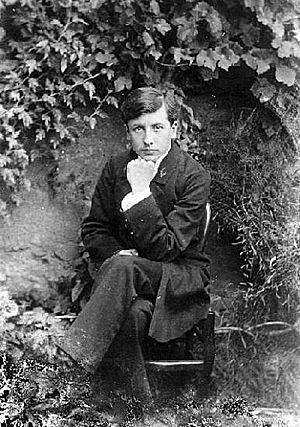Alain-Fournier facts for kids
Quick facts for kids
Henri-Alban Fournier
|
|
|---|---|
 |
|
| Born | Henri-Alban Fournier 3 October 1886 La Chapelle-d'Angillon, Berry, France |
| Died | 22 September 1914 (aged 27) near Vaux-lès-Palameix, Lorraine, France |
| Cause of death | Killed in action |
| Pen name | Alain-Fournier |
| Occupation | Novelist, critic, soldier |
| Nationality | French |
| Period | 1909–14 |
| Notable works | Le Grand Meaulnes |
| Military career | |
| Allegiance | |
| Service/ |
|
| Years of service | 1914 |
| Rank | Lieutenant |
| Battles/wars | First World War |
Alain-Fournier (born Henri-Alban Fournier) was a French writer and soldier. He was born on October 3, 1886, and died on September 22, 1914. He is famous for his only novel, Le Grand Meaulnes (published in 1913). This book has been made into movies twice and is a classic in French literature. The story in the book is partly based on his own childhood experiences.
Contents
About Alain-Fournier's Early Life
Alain-Fournier was born in a small town called La Chapelle-d'Angillon in central France. His father was a school teacher. He went to school near Paris, at the Lycée Lakanal. He tried to get into a special school for teachers, but he didn't succeed. Later, he studied at a school for the merchant navy in Brest.
At Lycée Lakanal, he became very good friends with Jacques Rivière. In 1909, Jacques Rivière married Alain-Fournier's younger sister, Isabelle.
Military Service and First Writings
In 1907, Alain-Fournier stopped his studies for a while. From 1908 to 1909, he served in the military. During this time, he started writing. He published some essays, poems, and short stories. These writings were later put together in a collection called Miracles.
Writing Le Grand Meaulnes
While he was writing, Alain-Fournier was also thinking about his famous novel, Le Grand Meaulnes. On June 1, 1905, he met a girl named Yvonne Marie Elise Toussaint de Quiévrecourt. He was very interested in her, but she did not feel the same way.
The next year, on the same day, he went back to the same place hoping to see her. But she did not come. He later told his friend Jacques Rivière that even if she had come, she wouldn't have been the same person he remembered. They didn't meet again for eight years. By then, she was married and had two children. This meeting inspired the character of Yvonne de Galais in his novel.
Finishing the Novel and Later Work
In 1910, Alain-Fournier moved back to Paris. He started working as a literary critic, writing for a newspaper called Paris-Journal. In 1912, he left that job to work for a politician named Casimir Perrier.
He finished Le Grand Meaulnes in early 1913. It was first published in a magazine and then as a book. The book was nominated for a big award, the Prix Goncourt, but it didn't win. The book is known in English as The Lost Domain.
Alain-Fournier's Death in World War I
In 1914, Alain-Fournier began working on a second novel, which he called Colombe Blanchet. However, he could not finish it. In August of that year, he joined the French Army as a lieutenant.
Just one month later, on September 22, 1914, he died fighting near Vaux-lès-Palameix during the First World War. For many years, his body was not identified. In 1991, his remains were finally found. He was then buried in the cemetery of Saint-Remy-la-Calonne.
After his death, many of Alain-Fournier's writings were published. This included Miracles (his poems and essays) in 1924, and his letters to his friend Jacques Rivière and his family. His notes for the unfinished novel Colombe Blanchet were also published.
Works by Alain-Fournier
- Le Grand Meaulnes
- Colombe Blanchet (an unfinished novel)
- Lettre au Petit B
- Miracles (a collection of poems and essays)
Inspiration for Artists
Alain-Fournier's famous novel, Le Grand Meaulnes, has inspired many artists. For example, a French sculptor named Jean-Louis Berthod created a large wooden carving in 2014. This artwork was inspired by the story of Le Grand Meaulnes.
See also
 In Spanish: Alain-Fournier para niños
In Spanish: Alain-Fournier para niños
- Nançay and the Loire Valley, places thought to be the setting for Le Grand Meaulnes
- Prix Alain-Fournier


